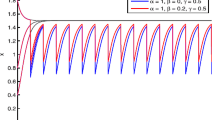Abstract
We consider both autonomous and nonautonomous population models subject to either impulsive or continuous harvesting. It is demonstrated in the paper that the impulsive strategy can be as good as the continuous one, but cannot outperform it. We introduce a model, where certain harm to the population is incorporated in each harvesting event, and study it for the logistic and the Gompertz laws of growth. In this case, impulsive harvesting is not only the optimal strategy but is the only possible one.
Similar content being viewed by others
References
Clark C.W. (1976). Mathematical Bioeconomics: The Optimal Management of Renewable Resources. Wiley, New York
Cooke K.L. and Witten M. (1986). One-dimensional linear and logistic harvesting models. Math. Model. 7: 301–340
Gao S.J., Chen L.S. and Sun L.H. (2005). Optimal pulse fishing policy in stage-structured models with birth pulses. Chaos Solutions Fractals 25(5): 1209–1219
Tang S., Cheke R.A. and Xiao Y. (2006). Optimal impulsive harvesting on non-autonomous Beverton–Holt difference equations. Nonlinear Anal. Ser. A: Theory Methods 65: 2311–2341
Xu C., Boyce M.S. and Daley D.J. (2005). Harvesting in seasonal environments. J. Math. Biol. 50: 663–682
Zhang X., Shuai Z. and Wang K. (2003). Optimal impulsive harvesting policy for single population. Nonlinear Anal. Real World Appl. 4: 639–651
Zhang Y., Xiu Z. and Chen L. (2006). Optimal impulsive harvesting of a single species with Gompertz law of growth. J. Biol. Syst. 14: 303–314
Fan M. and Wang K. (1998). Optimal harvesting policy for single population with periodic coefficients. Math. Biosci. 152: 165–177
Xiao Y., Cheng D. and Qin H. (2006). Optimal impulsive control in periodic ecosystems. Syst. Control Lett. 55: 556–565
Angelova J. and Dishliev A. (2000). Optimization problems for one-impulsive models from population Dynamics. Nonlinear Anal. 39: 483–497
Braverman E., Israeli M., Averbuch A. and Vozovoi L. (1998). A fast 3-D Poisson solver of arbitrary order accuracy. J. Comput. Phys. 144: 109–136
Boyce M.S. and Daley D.J. (1980). Population tracking of fluctuating environments and natural selection for tracking ability. Am. Nat. 115: 480–491
Chen L., Sun L. and Dong (2007). Optimal harvesting policies for periodic Gompertz systems. Nonlinear Anal. Real World Appl. 8: 572–578
Berezansky L. and Braverman E. (2004). On impulsive Beverton–Holt difference equations and their applications. J. Differ. Equ. Appl. 10: 851–868
Braverman E. (2005). On a discrete model of population dynamics with impulsive harvesting or recruitment. Nonlinear Anal. Ser. A: Theory Methods 63: e751–e759
Braverman E. and Kinzebulatov D. (2006). On linear perturbations of the Ricker model. Math. Biosci. 202: 323–339
Schreiber A.J. (2001). Chaos and population disappearances in simple ecological models. J. Math. Biol. 42: 239–260
Braverman, E., Mamdani, R.: On optimal impulsive sustainable harvesting, Dyn. Contin. Discrete Impuls. Syst. Ser. A Math. Anal. 14(S2) (suppl.), Adv Dynamical Syst., 112–116 (2007)
Artstein Z. (1993). Chattering limit for a model of harvesting in a rapidly changing environment. Appl. Math. Optim. 28: 133–147
Ludwig D. (1980). Harvesting strategies for a randomly fluctuating population. J. Cons. Int. Explor. Mer. 39: 168–174
Author information
Authors and Affiliations
Corresponding author
Additional information
The authors were partially supported by the NSERC Research Grant and the AIF Research Grant.
Rights and permissions
About this article
Cite this article
Braverman, E., Mamdani, R. Continuous versus pulse harvesting for population models in constant and variable environment. J. Math. Biol. 57, 413–434 (2008). https://doi.org/10.1007/s00285-008-0169-z
Received:
Revised:
Published:
Issue Date:
DOI: https://doi.org/10.1007/s00285-008-0169-z
Keywords
- Harvesting
- Impulsive equation
- Logistic model
- Periodic solutions
- Maximal sustainable yield
- By-catch mortality




